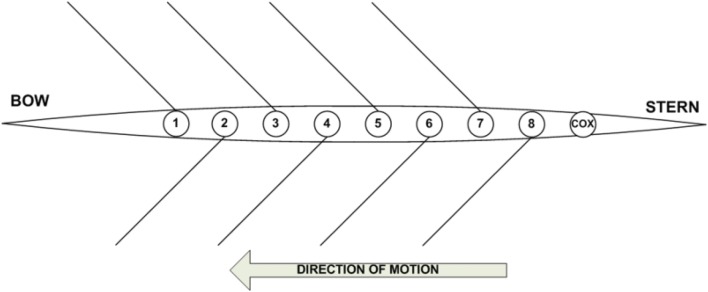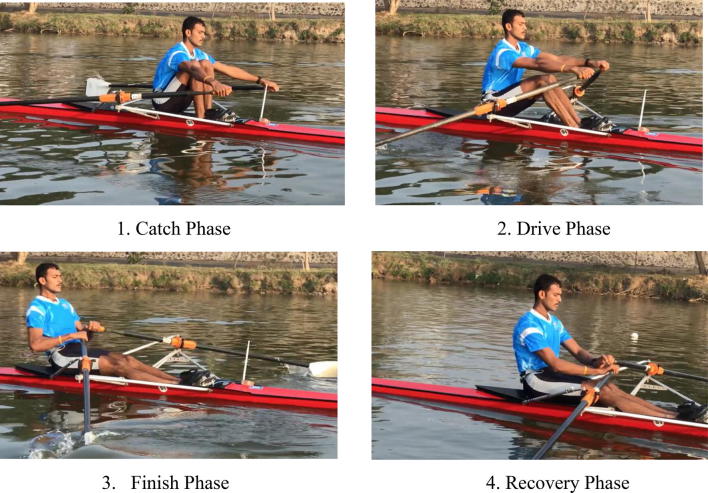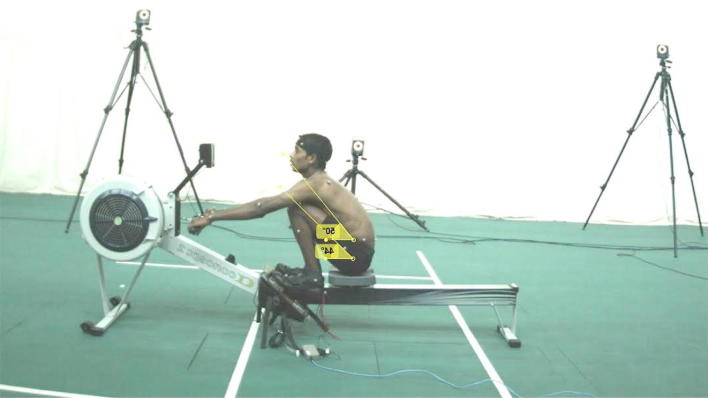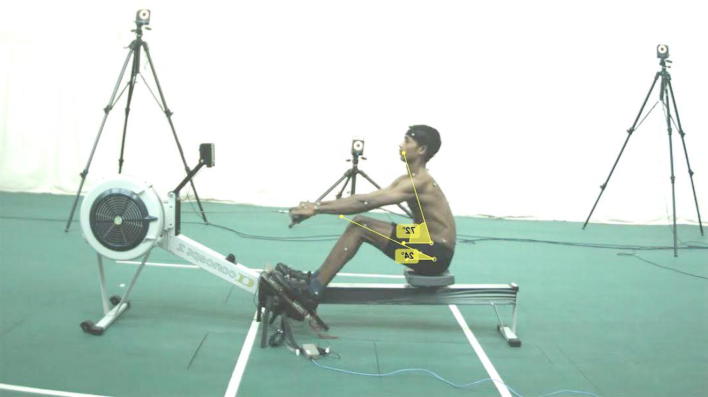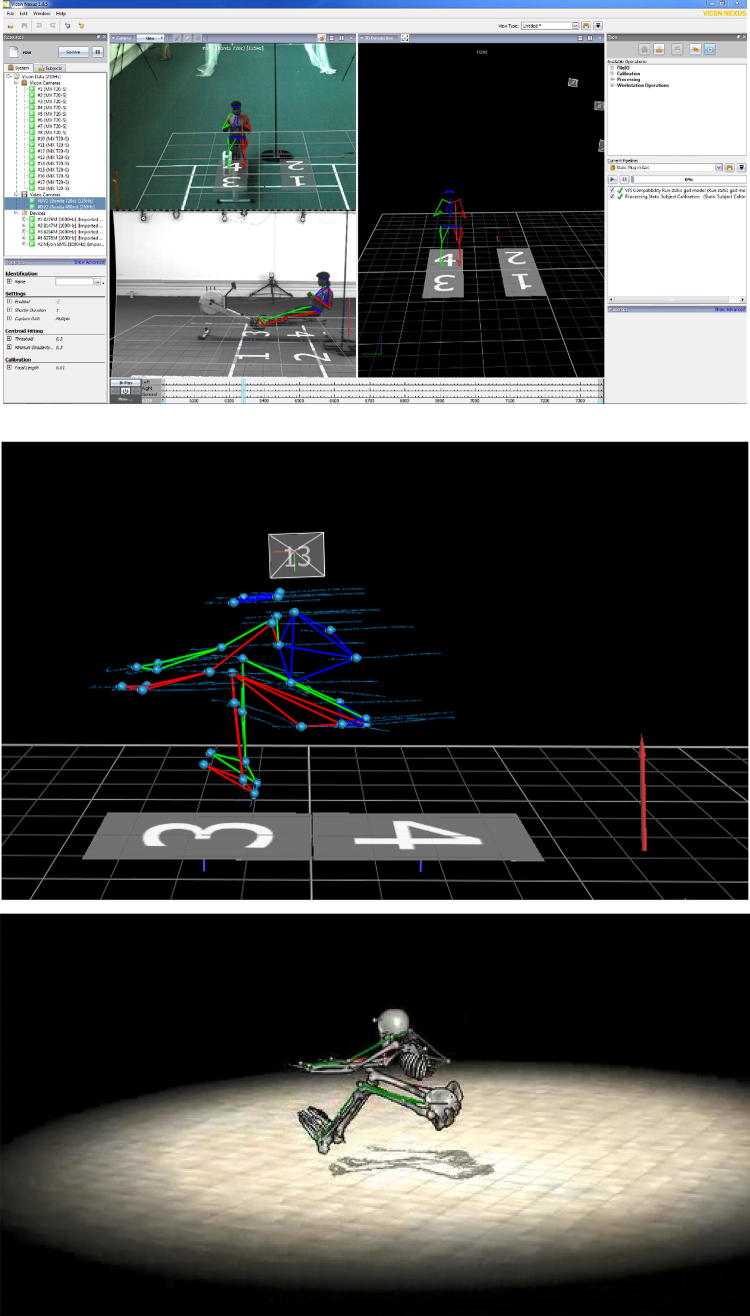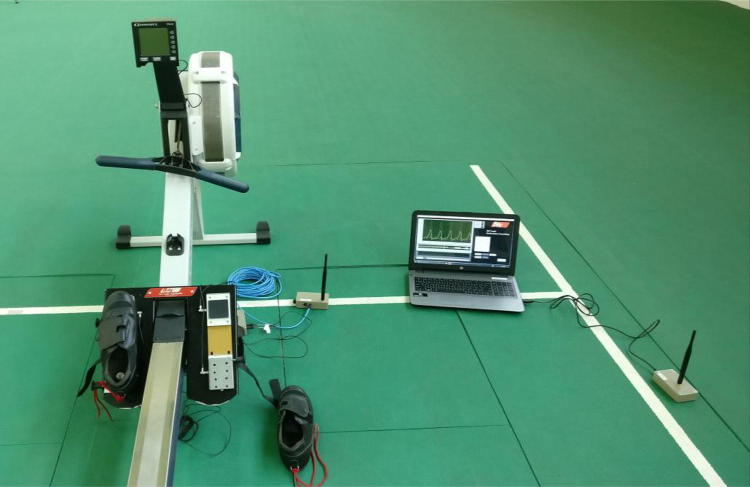Abstract
Background
Rowing is an Olympic sport gaining popularity in India and injuries are common in these athletes. Determinants of performance, injury risk and training are all interrelated in rowing. Injuries result from various risk factors including fitness issues and improper techniques. Rowers should have adequate leg extension strength and lumbo-pelvic coordination to produce and transmit power from the legs to the oar handle. Biomechanical analysis of the rowing stroke can help in preventing injuries and optimise technique for best performance. It involves a detailed and systematic observation of movement patterns to establish the quality of the movement and provide feedback to the rower about the key variables affecting performance and injury risk. Kinetics such as foot forces and kinematics such as key joint angles can be accurately measured by instrumented foot stretcher and three-dimensional motion capture.
Aim
To do a detailed review of literature regarding the incidence and risk factors for rowing injuries and to get an insight on the role of biomechanics in its management.
Materials and methods
Literature review was carried out with standard academic search engines and databases including Science Direct, PubMed and Google Scholar using keywords of relevance. A total number of 38 articles were analysed and results were collated to compile this review report.
Results
Lumbar spine is most commonly injured (up to 53%), followed by rib cage (9–10%) and shoulder and other anatomical areas. Rowers with a trunk-driven rowing action will have a lower hip:trunk score and carry a high injury risk. A player with lumbar injury will take a minimum of 3–4 months to recover.
Conclusion
Rowing injuries are common. Regular screening of the rowing athletes by comprehensive fitness and biomechanics assessment will help in prevention of injuries. Rowers need to be tested for pain, strength, flexibility, reproducibility of rowing action with modified mechanics, coordination, fatigue level, explosive power, aerobic and anaerobic endurance. Early recognition of risk factors and timely intervention is the key aspect of a successful return to play.
Keywords: Rowing injuries, Incidence, Biomechanics, Kinematics, Kinetics, Training, Instrumented Foot Stretcher, Prevention, Return to sport
Introduction
Rowing is an Olympic sport since its inception in 1896. There is an increasing enthusiasm among athletes in India to take up the sport. Indian Rowers have been a permanent fixture in the past 5 Olympics since 2000 Sydney Olympics. India is ranked 5th in Asian games with all time medal tally of 23 medals so far. The Government of India has included Rowing under the Khelo India program which fully supports young potential sportspersons in residential academies to excel at international level in their chosen sport.
With a steady increase in participation and popularity of Rowing, injuries are becoming a notable concern in these athletes. The advent of modern sports science has extended into the field of Rowing, where sports scientists strive to enhance rowing performance, by optimising rowing technique. As in most sporting events, determinants of performance, injury risk and training are all interrelated in Rowing as well.
The Sport of Rowing
Rowing is a sport that involves using a paddle known as an oar to propel a long boat through water at high speeds to win a race. There are two major types of rowing on water: Sweep rowing and Sculling [1]. In Sweep rowing, a single oar is handled by each member of the crew. Crew size can vary from 2 to 8. Bow side rowers place the blade of the oar to their left and stroke side rowers place the blade of the oar to their right. In Sculling, each athlete handles two symmetrical blades and can either perform as single scull or as double scull with two participants.
Rowing competition is further categorized based on two categories:
Heavy/Open Weight Category
- Lightweight Category
- Men: Individual < 72 kg, Crew average < 70 kg
- Women: Individual < 59 kg, Crew average < 57 kg
Olympic rowing races cover a distance of 2000 m. The objective is for the boat to reach the finish line in the quickest possible time. This requires high mental and physical strength specifically good cardiovascular endurance. Figure 1 demonstrates the outline of a sweep rowing boat, position of the rowers and the oars and direction of propulsion of the boat.
Fig. 1.
Rowing boat with position of rowers
Rowing Action
The four main phases of the rowing stroke are shown in Fig. 2. They are
Catch phase
Drive phase
Finish phase
Recovery phase
Fig. 2.
Four phases of Rowing
At the Catch, the oars are placed into the water with the Hips and Knees fully flexed. At this compressed position, there is a great deal of potential energy stored in the Legs, Back, and Arms to prepare for the Drive phase of the stroke. This is followed by the Legs driving the body back toward the bow of the boat; the Back, Shoulder, and Arms function as a braced cantilever so that the force generated by the Legs is transferred to the oars. The Drive phase ends at the Finish with the legs fully extended and elbows flexed into the body. The Recovery phase begins with movement of the hands away from the body followed by forward flexion at the hip and the forward movement of the spine resulting in the movement towards the Catch position again. This same cycle is repeated for the length of the race or practice. Thus, the rowing stroke requires precise segmental coordination of the entire kinetic chain with the core being the central unit transferring energy from the lower limbs to the oars via the upper limbs [2]. Ingham et al. [3] stated that to complete a rowing race approximately 75% aerobic energy and 25% anaerobic energy is required. Maximum oxygen consumption (VO2 max) can be reached up to 70 ml/kg/min in elite level rowers [4, 5].
Rowing Injuries
Rowing is a physically demanding sport, and injuries are common. A comprehensive list of injuries and their proposed patho-mechanisms are given in the Table 1.
Table 1.
Rowing injuries and their mechanisms
| Anatomical Site | Injury mechanism/risk factors | Injury type |
|---|---|---|
| Back |
Anterior compressive loads during higher degrees of lumbar flexion on inter-vertebral discs [6, 7] Repetitive loading due to lumbar extension and rotation causing stress reaction at pars [8] |
Nonspecific LBP Disc Herniation Spondylolysis Spondylolisthesis Facet Arthropathy |
| Chest |
Opposing stress induced by serratus anterior and external oblique- generating shear forces at end of drive phase [5] Transmitted force from oar handle and shoulder retractors (Latissmus and trapezius) results in rib cage compression [9] |
Rib Stress Fractures Costochondritis Serratus Anterior Avulsion Intercostal Muscle Strain |
| Shoulder | Compromised shoulder girdle positioning and stabilization due to weakness and overuse causing tight capsule, tight Latismus dorsi and decentralised Glenohumeral joint [10] |
Labral Injuries Scapular Dyskinesia Impingement Syndrome Clavicular Stress Fracture |
| Knee |
Deep flexion leading to high compressive forces between posterior surface of Patella and Femur [5] Increased abduction/ bowing of legs attributes to Iliotibial band syndrome (ITBS) |
Patellofemoral Pain Syndrome (PFPS) Patellar Subluxation/Dislocation Tendinopathies ITBS Quadriceps Tear |
| Hip | Repetitive flexion leading to increased mechanical stress on anterior chondro-labral junction [11] |
FAI or labral pathologies Snapping hip syndrome |
| Forearm/wrist | Excessive wrist motion during feathering of oars/tight grip, Improper initiation of drive at the elbow triggers Exertional compartment syndrome (ECS) [12] |
Lateral Epicondylitis De quervain’s Tenosynovitis Intersection Syndrome Exertional Compartment Syndrome Scullers Thumb |
| Nerve entrapment |
Tight hand grip Poorly fitted seat and prolonged training sessions [5] |
Carpal Tunnel Syndrome Sciatica |
| Skin | Changes in seat/ equipment type, intensity of training, climatic conditions and unclean oar handles |
Friction Blisters Callus Track Bites Hand Warts Pressure Sores |
Common Injuries
Low Back Pain (LBP) The region that is most frequently injured in rowing is the lumbar spine. Injuries to the lumbar spine account for up to 53% [13] of all reported injuries in rowing, making it the most frequently injured region, with an incidence of 1.5–3.7 per 1000 h of rowing and associated training [7, 14]. Non-specific low back pain accounts for over 30% of all injuries in Wilson et al.’s work [15] and 25% in Hickey et al.’s study [16].
Spondylolysis has a higher prevalence in rowers as compared with the general population at 17% in adult rowers versus 11.5% in general population [17]. A stress reaction at pars is seen in 22.7% of adolescent rowers [8]. Of studies that reported 12-month data, the incidence of low back pain ranged from 31.8 to 51% of the cohort [15]. The most commonly injured locations of the spine are the L4/L5 and L5/S1 discs owing to the large range of motion and compressive forces that occur there according to Humphrey et al [18]. Lumbar flexion is the most influential factor affecting the compressive loads as stated by Bono et al [19]. Inability to execute the rowing stroke with proper technique affects efficiency of power transmission and consequently the rowing performance and results in rowing injuries, particularly the lumbar spine region [20]. For instance, the biomechanical study performed on national sub-junior rowers at the Centre for Sports Science, Chennai revealed Mean Hip–Trunk Score less than 1.5 indicating that those athletes had a predominantly Trunk driven rowing action which is prone for spine injuries [21].
Rib Stress Injury (RSI) The incidence of rib stress injury is about 9–10% of all rowing injuries [22]. The term rib stress injuries (RSI) are an umbrella term used recently to cover the rib overuse injuries.
To minimise rib stress injuries, various modifications in the techniques have been proposed. Rowing with scapulae less protracted as the oar enters the water and using less retraction of scapulae at the end of the stroke and adopting less extreme layback reduces activity of the external obliques resulting in less force on the rib cage at the finish [23]. Strengthening of serratus anterior has a preventive role in RSI. The Great Britain rowing team has framed the guidelines for diagnosis and management of RSI which has a list of risk factors to consider and grading of severity in RSI [24, 25].
A special concern in the case of female athletes is warranted keeping in mind the relative energy deficiency, menstruation, and bone health. Training programs that increase leg to upper-body strength ratios with an added focus on lumbo-pelvic coordination, strength and their effects on rowing technique can be achieved through cross-training methods that aid in preventing injuries to the upper body [26]. Strengthening the core and thoracic muscle co-contraction exercises are to be included.
Less Common Injuries
Shoulder Shoulder injuries result from muscle imbalances and improper techniques. The shoulder pain lasts from 1 year up to a lifetime in elite rowers [27]. Long-term management involves correcting muscle imbalances by strengthening scapula–thoracic stabilizers, stretching the neck muscles, postural realignment and technique modification.
Knee Anterior knee pain can be prevented by modifying the position of the shoes in the boat with or without heel wedging [28]. Assessment of hamstring flexibility and strength, quadriceps strengthening and correcting the imbalance between Vastus medialis and lateralis will prevent mal-tracking of patella.
Forearm and wrist Forearm and wrist injuries occur due to the feathering action of the oar when it is brought parallel to the water surface in the recovery phase. Moreover, tight grip, wrongly sized handles, increased force from elbow rather than shoulders and climatic conditions aggravate this pathology [28]. Modifying the upper arm and forearm biomechanics and training without feathering for some time will be of use.
Biomechanics of Rowing
Biomechanics is one of the domains in sport science which focuses on studying and analysing human movement patterns. Biomechanical assessment has been extensively used in other sports for performance enhancement and identifies areas of injury risk. In Rowing, it can be used to analyse the rowing stroke to help optimise technique for best performance and prevent injuries [29]. Biomechanical analysis involves a detailed, structured and systematic observation of movement patterns to establish the quality of the movement and provide feedback to the performer about the key variables relating to movement patterns and joint forces. Analysing the Kinematics (study of movements and joint angles) and the Kinetics (foot forces generated) are integral to this (Table 2).
Table 2.
Types of biomechanics assessment methods in rowing
| No | Biomechanics assessment | Application |
|---|---|---|
| 1 | 3 Dimensional motion capture and analysis | Accurate Kinematic data including joint movements, angles etc. |
| 2 | 2 Dimensional video analysis | Gross Kinematic data of joint movements, angles etc |
| 3 | Instrumented Foot Stretcher analysis | Kinetic analysis of forces imposed on the foot stretcher of rowing boat/ergometer |
Kinematics—3D Motion Capture and 2D Video Analysis
Accurate Kinematics data about Hip, Knee and Trunk ROM at all phases can be derived from the 3D motion capture analysis, whereas the HT Score (Hip–Trunk score) can be derived from the 2D video analysis using the formula:
Rowers with a trunk driven rowing action will have a lower HT score carry a high injury risk [30] (Figs. 3, 4, 5).
Fig. 3.
3-D motion capture and video analysis of rowing biomechanics hip and trunk angles at catch
Fig. 4.
3-D motion capture and video analysis of rowing biomechanics hip and trunk angles at MHF
Fig. 5.
3-D motion capture analysis with Vicon Software
Kinetics—Force Analysis
It is vital to measure kinetic variables such as foot forces during rowing and determine the force asymmetries. This can be done by Instrumented Foot Stretcher systems. Changes in rowing kinematics influence the foot force production and cause foot asymmetries which in turn influence lumbar and pelvic kinematics [31].
Instrumented Foot Stretcher System Instrumented Foot Stretchers measure efficiency and quality of rowing stroke and thus help in enhancing performance and assessing injury risk. The equipment consists of load cells which are the force transducers. These load cells are fixed onto the footplates using screws. Rowing shoes fitted onto these load cells capture Toe and Heel forces of both the Left and Right feet. The forces are amplified and transmitted from the Load cells to a transmitter box via the amplifier. These signals are then transmitted to the receiver which would be connected to the computer and data recorded using suitable software. Peak foot force (Toe + Heel), Heel Asymmetry Index, Heel Engagement and Force Profile can be obtained from the analysis. Proprietary Instrumented Foot Stretchers by BATLogic system, Australia are very popular and have become global standard in elite Olympic Rowers. This technology has now come to India and is being utilised at the Centre for Sports Science, Chennai, which is a Sports Authority of India accredited centre of excellence (Fig. 6).
Fig. 6.
Instrumented Foot Stretcher system with load cell
In a recent study conducted at the Centre for Sports Science, Chennai, a group of elite national rowers underwent Biomechanical assessment and their Kinematic and Kinetic variables were assessed from injury risk and performance angles [21]. The table below summarises the findings and highlighting the following points:
Higher Hip range of movement from Catch to Finish correlates with better performance.
Significant proportion of rowers had low Hip–Trunk Ratio score and thus were at injury risk
Good Peak Foot Forces correlated well with higher performance
Significant proportion of rowers had foot force asymmetries, late heel engagement and poor force profiles implying sub-optimal performance and injury risk (Table 3).
Table 3.
Kinetic and Kinematic variables of elite Indian national-level rowers (study conducted at Centre for Sports Science, Chennai)
| Variable | Comments |
|---|---|
| Kinematic | |
| Knee ROM (from Catch to Finish) | No correlation with performance |
| Hip ROM (from Catch to Finish) | Correlated with performance |
| Trunk ROM (from Catch to Finish) | No correlation with performance |
| Hip–Trunk Ratio Score: Trunk driven – Greater injury risk | Significant proportion of rowers were at injury risk |
| Kinetic | |
| Peak Foot Force (Toe + Heel) | Correlated with performance |
| Asymmetry Index | Significant proportion of rowers had asymmetry |
| Heel Engagement and its timing—Qualitative | Late heel engagement found in many rowers |
| Force Profile—Qualitative | Poor force profile found in many rowers |
Strategies for Injury Prevention
Prevention of low back pain (LBP) in rowers poses a tough challenge, as it is recurrent in rowers with previous history of lumbar spine injury. Wilson et al. [32] conclude that the factors associated with onset of low back pain in rowers are history of injury and ergometer training volume (sessions longer than 30 min). Lumbo-pelvic motion is the key aspect. Excessive use of lumbar flexion and extension with less or nil pelvic tilting attributes to excessive lumbar spine loading. Endurance of trunk muscles is important to facilitate good lumbo-pelvic rhythm [33]. Factors such as fatigue, rowing intensity and skill level will also influence trunk control. Maintenance of some degree of flexion rather than a straight back is recommended.
A comprehensive approach is mandatory for assessing the athletes for potential injury [34]. Few of the domains to be given importance are listed in Table 4.
Table 4.
Strategies for injury prevention
| No | Key strategies for injury prevention |
|---|---|
| 1 | Recognition of intrinsic risk factors of athlete—gender, age, anthropometry |
| 2 | Pre-participation Screening for pre-existing medical conditions |
| 3 | Formulating a well-designed pre-season Training Program |
| 4 | Understanding key components in Training (Intensity, Volume and Frequency) |
| 5 | Monitoring changes with Equipment, Technique and Environmental Conditions |
| 6 | Assessing Biomechanical Parameters |
| 7 | Identifying deficiencies in Balance and Strength |
| 8 | Standardisation of Warm-Up and Cool Down sessions |
| 9 | Timely management of injuries |
| 10 | Allowing adequate time period for recovery |
| 11 | Tailored Return To Sports assessment criteria |
Several randomized controlled trials to validate a core-specific training have been done in Rowing. An 8-week rowing specific core strengthening program designed by Tse et al. [35], involved 45 collegiate rowers. The core endurance-training program improved selected core endurance parameters in healthy young men, but the effectiveness of the core intervention on various functional performance aspects was not supported. Functional kinetic chain exercises have also been emphasized in injury prevention training by DeMey and colleagues [26].
Return to Sports
Early recognition of identifiable risk factors and their timely intervention are the key aspects of the successful return to sport. Studies pertaining to RTS guidelines are limited and short of arriving at a consensus. To add to it, RTS is both player as well as injury specific. Hence framing an individualised checklist with Fitness and technique parameters based on his or her profile and requirements seems to be a feasible alternative. After pain control and adequate rehabilitation, graded return to sports is advisable with standard rowing specific assessments. Clearing athletes with lumbar injury/LBP could take a minimum of 3–4 months [13] following testing them for pain, strength, flexibility, reproducibility of rowing action with modified mechanics, coordination, fatigue level, explosive power, aerobic and anaerobic endurance. A few studies have noted that RTS in case of Spondylosis takes 5–7 months after diagnosis [28]. Elite Rowers with a Rib Stress Injury respond well with 3 to 8 weeks of rest and modified training [36]. Bench Press, Bench Pull and Abdominal exercises place compressive forces on Ribs hence have to be incorporated in the last phase of rehabilitation. In addition, return to low-level impact rowing is suggested for 1–2 weeks [37].
Recommendations
The following recommendations stem from the review of research in this subject:
Rowers and coaches need to be sensitised regarding the injury risks and early symptoms of injury and should be encouraged to seek clinical and sports science support at the earliest.
All rowers should be subjected to regular medical and scientific assessments at least twice in a year.
Elite Rowers should be regularly analysed using latest Biomechanical methods including 3D motion capture and Instrumented Foot Stretcher systems
Practicing clinicians are required to update their knowledge and skills pertaining to the latest scientific developments in assessment and management of rowing related injuries.
An evidence-based approach to the injury management and rehabilitation of the injured rowers needs to be followed with good teamwork
Return to Sport decision should be based on sound grounds of medical and fitness assessments.
Conclusion
Rowing is gaining popularity in India and injuries are becoming common due to fitness and technique issues. A systematic approach including regular clinical screening of the athletes with scientific assessment using Biomechanics can help prevent injuries and improve performance among Rowers. Existing injuries need to be identified early and managed in a methodical way for enabling the athletes to return to sport in an optimal status. Medical fraternity thus could play a major role in keeping the Rowing athletes in good condition for them to realise the dream of achieving well at international level including the Olympics.
Compliance with Ethical Standards
Conflict of interest
The authors declare that they have no conflict of interest.
Ethical approval
This review article does not contain any studies with human participants or animals performed by any of the authors.
Informed consent
For this type of article, formal consent is not applicable.
Footnotes
Publisher’s Note
Springer Nature remains neutral with regard to jurisdictional claims in published maps and institutional ailiations.
References
- 1.Hofmijster MJ, Soest VAN, Koning JJ DE. Rowing skill affects power loss on a modified rowing ergometer. Medicine and Science in Sports and Exercise. 2008;40(6):1101–1110. doi: 10.1249/MSS.0b013e3181668671. [DOI] [PubMed] [Google Scholar]
- 2.Hosea TM, Hannafin JA. Rowing injuries. Sports Health. 2012;4(3):236–245. doi: 10.1177/1941738112442484. [DOI] [PMC free article] [PubMed] [Google Scholar]
- 3.Ingham SA, Whyte GP, Jones K, Nevill AM. Determinants of 2,000 m rowing ergometer performance in elite rowers. European Journal of Applied Physiology. 2002;88(3):243–246. doi: 10.1007/s00421-002-0699-9. [DOI] [PubMed] [Google Scholar]
- 4.Karlson KA. Rowing Injuries. The Physician and Sportsmedicine. 2000;28(4):40–50. doi: 10.3810/psm.2000.04.837. [DOI] [PubMed] [Google Scholar]
- 5.Secher NH. Physiological and biomechanical aspects of rowing. Implications for training. Sports Medicine. 1993;15(1):24–42. doi: 10.2165/00007256-199315010-00004. [DOI] [PubMed] [Google Scholar]
- 6.O’Kane JW, Teitz CC, Lind BK. Effect of preexisting back pain on the incidence and severity of back pain in intercollegiate rowers. American Journal of Sports Medicine. 2003;31(1):80–82. doi: 10.1177/03635465030310012501. [DOI] [PubMed] [Google Scholar]
- 7.Newlands C, Reid D, Parmar P. The prevalence, incidence and severity of low back pain among international-level rowers. British Journal of Sports Medicine. 2015;49(14):951–956. doi: 10.1136/bjsports-2014-093889. [DOI] [PubMed] [Google Scholar]
- 8.Maurer M, Soder RB, Baldisserotto M. Spine abnormalities depicted by magnetic resonance imaging in adolescent rowers. American Journal of Sports Medicine. 2011;39(2):392–397. doi: 10.1177/0363546510381365. [DOI] [PubMed] [Google Scholar]
- 9.Warden SJ, Gutschlag FR, Wajswelner H, Crossley KM. Aetiology of rib stress fractures in rowers. Sports Medicine (Auckland, N. Z.) 2002;32(13):819–836. doi: 10.2165/00007256-200232130-00002. [DOI] [PubMed] [Google Scholar]
- 10.Izraelski J. Assessment and treatment of muscle imbalance: The Janda approach. Journal of the Canadian Chiropractic Association. 2012;56(2):158. [Google Scholar]
- 11.Boykin RE, McFeely ED, Ackerman KE, Yen Y-M, Nasreddine A, Kocher MS. Labral injuries of the hip in rowers. Clinical Orthopaedics and Related Research. 2013;471(8):2517–2522. doi: 10.1007/s11999-013-3109-1. [DOI] [PMC free article] [PubMed] [Google Scholar]
- 12.Rumball JS, Lebrun CM, Di Ciacca SR, Orlando K. Rowing injuries. Sports Medicine (Auckland, N. Z.) 2005;35(6):537–555. doi: 10.2165/00007256-200535060-00005. [DOI] [PubMed] [Google Scholar]
- 13.Bahr R, Andersen SO, Løken S, Fossan B, Hansen T, Holme I. Low back pain among endurance athletes with and without specific back loading–a cross-sectional survey of cross-country skiers, rowers, orienteerers, and nonathletic controls. Spine. 2004;29(4):449–454. doi: 10.1097/01.BRS.0000096176.92881.37. [DOI] [PubMed] [Google Scholar]
- 14.Ng L, Perich D, Burnett A, Campbell A, O’Sullivan P. Self-reported prevalence, pain intensity and risk factors of low back pain in adolescent rowers. Journal of Science and Medicine in Sport. 2014;17(3):266–270. doi: 10.1016/j.jsams.2013.08.003. [DOI] [PubMed] [Google Scholar]
- 15.Wilson F, Gissane C, Gormley J, Simms C. A 12-month prospective cohort study of injury in international rowers. British Journal of Sports Medicine. 2010;44(3):207–214. doi: 10.1136/bjsm.2008.048561. [DOI] [PubMed] [Google Scholar]
- 16.Hickey GJ, Fricker PA, McDonald WA. Injuries to elite rowers over a 10-yr period. Medicine and Science in Sports and Exercise. 1997;29(12):1567–1572. doi: 10.1097/00005768-199712000-00004. [DOI] [PubMed] [Google Scholar]
- 17.Soler T, Calderón C. The prevalence of spondylolysis in the Spanish elite athlete. American Journal of Sports Medicine. 2000;28(1):57–62. doi: 10.1177/03635465000280012101. [DOI] [PubMed] [Google Scholar]
- 18.Humphreys, S. C., & Eck, J. C. (1999). Clinical evaluation and treatment options for herniated lumbar disc. American Family Physician 59(3), 575–582, 587–8. [PubMed]
- 19.Bono CM. Low-back pain in athletes. Journal of Bone and Joint Surgery American. 2004;86(2):382–396. doi: 10.2106/00004623-200402000-00027. [DOI] [PubMed] [Google Scholar]
- 20.Reid D, Mcnair P. Factors contributing to low back pain in rowers. British Journal of Sports Medicine. 2000;34(5):321–322. doi: 10.1136/bjsm.34.5.321. [DOI] [PMC free article] [PubMed] [Google Scholar]
- 21.Arumugam, S., et al. (2018). Does stroke rate affect rowing biomechanics? In Proceedings of the 2nd ASEAN sports medicine conference, Malaysia
- 22.McDonnell LK, Hume PA, Nolte V. Rib stress fractures among rowers: Definition, epidemiology, mechanisms, risk factors and effectiveness of injury prevention strategies. Sports Medicine. 2011;41(11):883–901. doi: 10.2165/11593170-000000000-00000. [DOI] [PubMed] [Google Scholar]
- 23.Christiansen E, Kanstrup IL. Increased risk of stress fractures of the ribs in elite rowers. Scandinavian Journal of Medicine and Science in Sports. 1997;7(1):49–52. doi: 10.1111/j.1600-0838.1997.tb00117.x. [DOI] [PubMed] [Google Scholar]
- 24.Evans G, Redgrave A. Great Britain Rowing Team Guideline for diagnosis and management of rib stress injury: Part 1. British Journal of Sports Medicine. 2016;50(5):266–269. doi: 10.1136/bjsports-2015-095126. [DOI] [PubMed] [Google Scholar]
- 25.Evans G, Redgrave A. Great Britain rowing team guideline for diagnosis and management of rib stress injury: Part 2—The Guideline itself. British Journal of Sports Medicine. 2016;50(5):270–272. doi: 10.1136/bjsports-2015-095928. [DOI] [PubMed] [Google Scholar]
- 26.De Mey K, Danneels L, Cagnie B, Cools A. Are kinetic chain rowing exercises relevant in shoulder and trunk injury prevention training? British Journal of Sports Medicine. 2011;45(4):320. doi: 10.1136/bjsm.2011.084038.30. [DOI] [Google Scholar]
- 27.Mohseni-Bandpei MA, Keshavarz R, Minoonejhad H, Mohsenifar H, Shakeri H. Shoulder pain in Iranian elite athletes: The prevalence and risk factors. Journal of Manipulative and Physiological Therapeutics. 2012;35(7):541–548. doi: 10.1016/j.jmpt.2012.07.011. [DOI] [PubMed] [Google Scholar]
- 28.Thornton JS, Vinther A, Wilson F, Lebrun CM, Wilkinson M, Di Ciacca SR, et al. Rowing injuries: An updated review. Sports Medicine (Auckland, N. Z.) 2017;47(4):641–661. doi: 10.1007/s40279-016-0613-y. [DOI] [PubMed] [Google Scholar]
- 29.Chung LH, Remelius JG, Van Emmerik REA, Kent-Braun JA. Leg power asymmetry and postural control in women with multiple sclerosis. Medicine and Science in Sports and Exercise. 2008;40(10):1717–1724. doi: 10.1249/MSS.0b013e31817e32a3. [DOI] [PubMed] [Google Scholar]
- 30.Buckeridge EM, Bull AMJ, McGregor AH. Foot force production and asymmetries in elite rowers. Sports Biomechanics. 2014;13(1):47–61. doi: 10.1080/14763141.2013.861013. [DOI] [PubMed] [Google Scholar]
- 31.Bull AM, McGregor AH. Measuring spinal motion in rowers: the use of an electromagnetic device. Clin Biomech (Bristol, Avon). 2000;15(10):772–776. doi: 10.1016/S0268-0033(00)00043-7. [DOI] [PubMed] [Google Scholar]
- 32.Wilson F, Gissane C, McGregor A. Ergometer training volume and previous injury predict back pain in rowing; strategies for injury prevention and rehabilitation: Table 1. British Journal of Sports Medicine. 2014;48(21):1534–1537. doi: 10.1136/bjsports-2014-093968. [DOI] [PubMed] [Google Scholar]
- 33.Kingma I, van Dieën JH, de Looze M, Toussaint HM, Dolan P, Baten CT. Asymmetric low back loading in asymmetric lifting movements is not prevented by pelvic twist. Journal of Biomechanics. 1998;31(6):527–534. doi: 10.1016/S0021-9290(98)00045-1. [DOI] [PubMed] [Google Scholar]
- 34.Cook G, Burton L, Hoogenboom B. Pre-participation screening: The use of fundamental movements as an assessment of function—Part 1. North American Journal of Sports Physical Therapy. 2006;1(2):62–72. [PMC free article] [PubMed] [Google Scholar]
- 35.Tse MA, McManus AM, Masters RSW. Development and validation of a core endurance intervention program: implications for performance in college-age rowers. The Journal of Strength and Conditioning Research. 2005;19(3):547–552. doi: 10.1519/15424.1. [DOI] [PubMed] [Google Scholar]
- 36.McGregor AH. Injury prevention, performance and return to sport: How can science help? Chinese Journal of Traumatology. 2017;20(2):63–66. doi: 10.1016/j.cjtee.2016.11.005. [DOI] [PMC free article] [PubMed] [Google Scholar]
- 37.McNally E, Wilson D, Seiler S. Rowing injuries. Seminars in Musculoskeletal Radiology. 2005;09(4):379–396. doi: 10.1055/s-2005-923381. [DOI] [PubMed] [Google Scholar]



